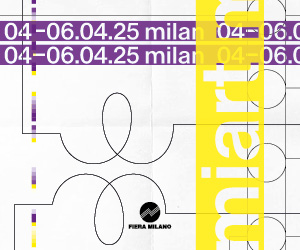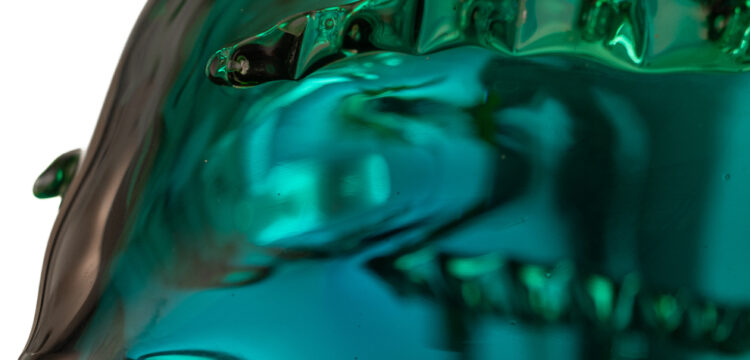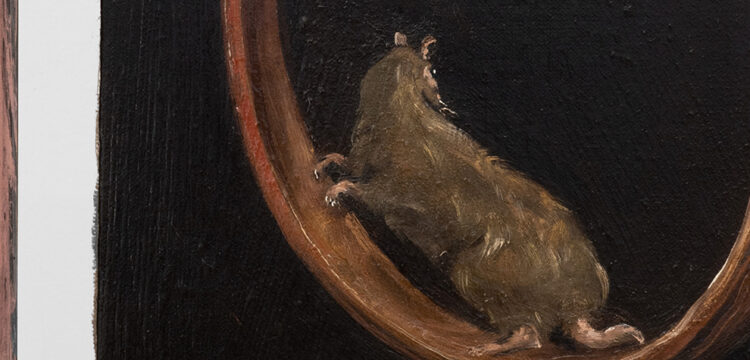Something Falls From All Hands
Cesare Pietroiusti, Silvia Fanti and Daniele Gasparinetti (Xing) in conversation
Xing has just produced a new LP by Cesare Pietroiusti, NEWTON, fourteenth release of the XONG collection-artist records. The release is on white vinyl, in a limited and numbered edition of 150 copies, together with a print run of 30 collector’s editions, each of which will be sent directly by the artist, as a work of mail art, in a unique packaging for each copy made specifically for this occasion.
NEWTON is a sound work conceived by Cesare Pietroiusti, an artist interested in micro-events, paradoxical situations, behaviour and minor gestures that make up our daily life. NEWTON is an epic of the fall, experienced, suffered and observed by the artist himself.
For about two months Pietroiusti recorded with a Lavalier microphone connected to a small portable recorder, which he mostly kept attached to the waistband of his trousers, the sound produced by all the falling objects caused, directly or indirectly, by him. “Things that slip out of the hands, things that fall because they are caught in the movement of other things, things that one trips over or bumps into, things that are badly placed somewhere, things that are unseen. In all cases they are accidental and unplanned falls, due to clumsiness, errors of judgement, distraction, haste. Events that refer to whatever objects: coins, clothes, tools, keys, bottle tops, etc.,” and which the artist defines micro-traumatic because “despite their disarming and ordinary banality, they remind us of our subjection—which is both adaptation and contrast, use and failure—to the force of gravity.”
The record contains, on side A, the sounds of the falls, isolated and recomposed in the form of a suite, while, on side B, they are accompanied by a verbal description of the accident that has just occurred, made “on the spot.” An ostinato that engages the listener in a well known and unavoidable experience as Newton’s law of universal gravitation.
XING: Nothing stems out of nothing. In the dynamics of engaging a range of artists and collectives who were invited in the strange enterprise of Xong, we cannot deny that we were inspired by some historical background that had, unlike the ephemeral performance field, sedimented documentary traces not on paper but on record. Minor histories to be inventoried as “miscellaneous,” both with respect to the vast field of plastic arts and to that of the cultural industry, connected to the age of technical reproducibility.
Few people in Italy have dealt with it, and the only museum that to us seems to have started an activity of collecting and preserving these phonographic “documents” is the GAM in Turin, thanks to Elena Volpato’s work. From the point of view of not-yet-systematised historical studies, Fabio Acca and a few others have recently dealt with it.*
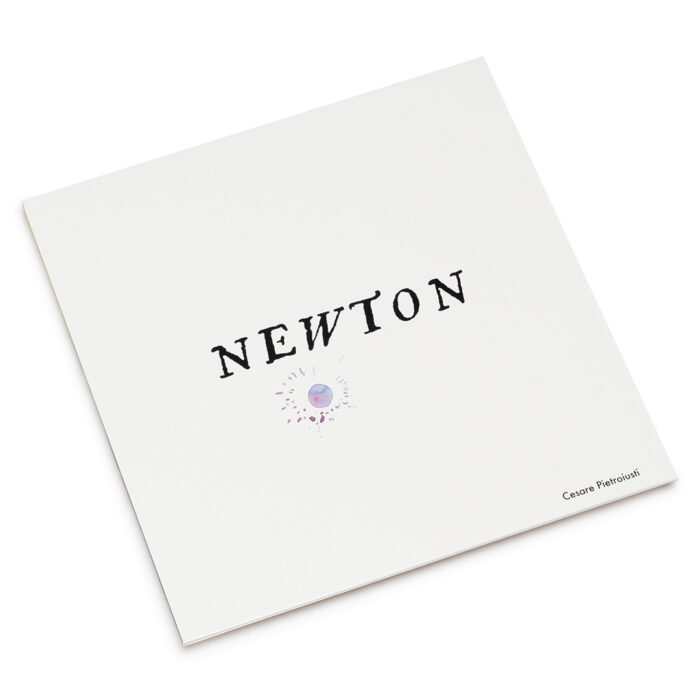
LP cover Cesare Pietroiusti, NEWTON (Xong collection, Xing 2024); image cover Goccia su goccia (detail), 2010-2024. Photo Soundohm. Courtesy the artist and Xing.
Xing has always been interested in the space of the scene. But here we are talking about the space of the record, which is another kind of “scene.” The sonic dimension is one of the aspects that can echo the space of the action, rather than the action itself. The mimetic aspect of the Xong collection is not the point. In fact, in this series of works commissioned to some 20 artists from the live arts world, it was not about documenting actions, but about imagining a different media/platform that could convey a physicality of the event, and communicate a conduction of time. Paradoxically, sound is only one aspect of the creation/production of these records, which from our point of view is an editorial, rather than a record label. Just as we prefer to speak of sonic phenomena (which also includes silence, for example) rather than sound, to emphasise a phenomenal complexity that goes beyond the (musical) composition, and expands it in multiple directions, as a reverberation chamber reconfigures the device between the happening and its recording. This is the playing field we envisioned three years ago.
Thus we are near and far from certain historical experiences such as those of the post-avant-gardes or Fluxus. From the ’60s and ’70s until the late ’90s there were remarkable examples of artist’s records in Italy: from spoken word to sound poetry, experimental radio, concrete music, Nuovo teatro made in Italy… with some important series, as for instance the RADIO TAXI series or Cramps records, up to the current heir Alga Marghen. Or think of the unicum JA JA JA Ne Ne Ne by Beuys (1969, Gabriele Mazzotta editions) or the LP Crollo nervoso by Magazzini Criminali (1980, Italian records). Following the tradition of the post-avant-gardes, these fields remain undefined.
Of course, in the case of “conceptual” artists (we are not sure whether we can count Cesare Pietroiusti in this group), it is rather obvious that such a “concept” can be expressed on any platform, media, or context: it is nothing new.
Just to quote one of the many conversations we had with Cesare, who has good analytical skills, in this publishing project we are dealing with “cases,” (casi in Italian) each in its absolute singularity. For Xong’s fourteenth issue, an open question remains: is there a case that exemplarily interprets the format we are pursuing?
Cesare Pietroiusti: Although I have no musical skills, the “sound” dimension of the artwork has always interested me greatly. In my first solo exhibition (Jartrakor, Rome, April 1978) there was an installation with two speakers on opposite sides of a long room: the first, placed on a chair, emitted a recording of a normal breath. Every few minutes, the breath would stop and be replaced by the sound of a running noise ending with a sharp thump, as of a body violently hitting a wall, which could be heard on the second speaker (at the time I was unaware that Barry Le Va had done a very similar work ten years earlier…).
But perhaps the work that can be considered a precedent of NEWTON is An Ordinary Day, a series of short-term memorization exercises, from 2005. In that case, over a 24-hour period, I tried to notice and describe verbally in a tape recorder, all the gestures, actions, thoughts in which an intention of mine failed to be fulfilled, at least not immediately or not completely; thus micro-failures, missed acts, big or small oversights, mistakes, without forgetting any of them, not even the most insignificant ones. Obviously, in that recording, the descriptive and verbal aspect prevailed, but I had made, even in that case, an attempt to restore the noises, the background setting: the sound context in which I was describing the fact that the seat belt got stuck in the car door was very different from the one in which, say, I was recounting the impossibility of finding two identical socks in the drawer while dressing my daughter.
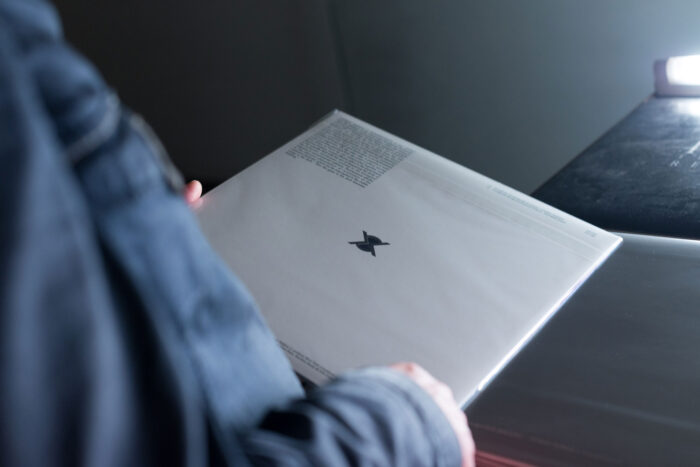
XING: Comedy, repetition, humanity, recognition, and disavowal. For Bergson, “There is no comedy outside what is properly human.” Laughter and comedy are the opposite of identification and empathy. To laugh one must remain a spectator and not empathise with those in front of us. Laughter is a temporary suspension of sympathy. “The greatest enemy of laughter is emotion.”
Cesare Pietroiusti: It seems clear to me that NEWTON is an ironic work. However, I believe that, with respect to Bergson’s observation, for the listener the irony here lies fundamentally in a form of identification with happenings that affect everyone, but which are not taken into account except as small, inevitable annoyances of an existence at its most ordinary and mundane state. From all hands something falls, at times; all elbows bang and drop objects in precarious balance. All these are commonplaces, and it is just “laughable” that someone (an artist) would consider making a work out of it. There is no pathos, but micro-memories of something that has already happened to you or someone else, indeed.

Logo Xong collection, artist records. Art caspar/Xing.
XING: What about trauma and default as performative or anti-performative?
Cesare Pietroiusti: If we already think only of all the words we commonly use that are derived from the (Latin) verb cadere—accident, incident, occasion, chance (caso in Italian), happening (accadimento), etc.—and to all the moral or psychological connotations that we associate with the (Italian) verb “cadere”—from “fall down” to “fall into misery,” from “fall into disuse” to “fall into the void”—we realise the presence and “heaviness” of the meaning of fall in our lives and our thinking. Not to mention the meanings of the word “grave”… Gravity is evidently a default condition that affects the entire planet and, just as it makes our actions possible, so it determines the difficulties that accompany them. When we walk quietly down the street or cook a plate of rice in the kitchen, we do not realise it, but already if we have to lift a suitcase on a train, our feeling changes. When a coin slips through our fingers and falls, especially if we are tired or have a bad back, we can really feel a foreign and malignant force that, literally, takes something out of our hands, in the direction of the centre of the earth. It is traumatic not because it brings about who knows what transformations in our psychic apparatus, but because it offers us the awareness of a pervasive, inevitable, most powerful physical conditioning. It is traumatic precisely because it is “micro” and emerges in small falls: in “cases” more than in accidents.
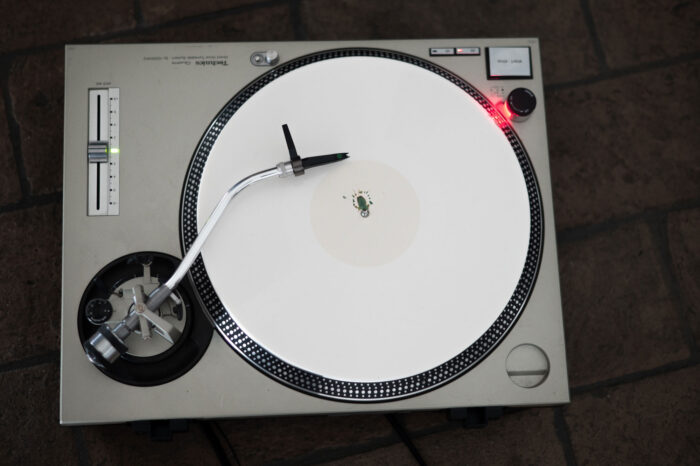
XING: How much psychoanalytic expertise emerges in the description of the falls that is engraved on the record?
Cesare Pietroiusti: On a conscious level, while I was recording what was happening to me (sic), I seem to have been more conditioned by the s-forzo (“effort” in English, and considering this word, the force that the “s” opposes seems to be fundamentally the force of gravity) of describing as concisely but also as faithfully and comprehensibly as possible, the event that had just… happened (accaduto).
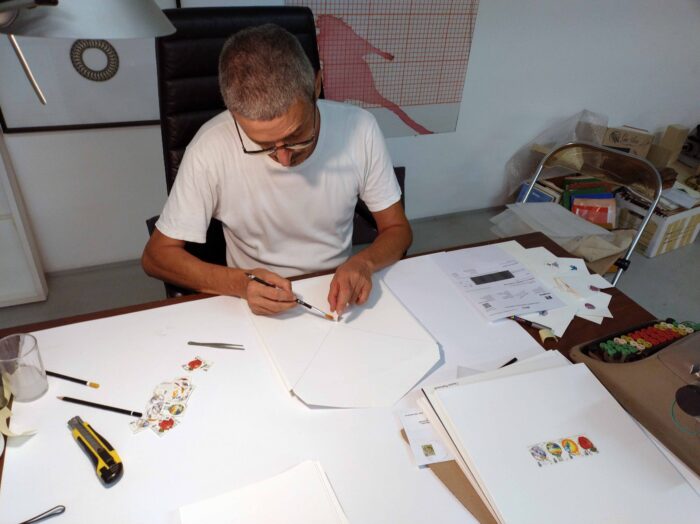
XING: Falling on their feet, after all animals can’t make anything fall, they don’t have hands to do it,—they are not clumsy—having not assumed the upright position that amplifies the effects of falling (gravitational, Newton), they do not belong to the world of catastrophe.
Cesare Pietroiusti: Yes, it is true; it is as if everything is already down for them. On “falling on your feet,” I was thinking of so-called artistic gymnastics or, even better, dance. The challenge of dance is to counteract the force of gravity with such mastery that you can use it, play with it, make it disappear and reappear at will. And the fundamental object, the “grave” one, is the dancer’s own body: it is the zero degree of the performer’s involvement in their own performance.
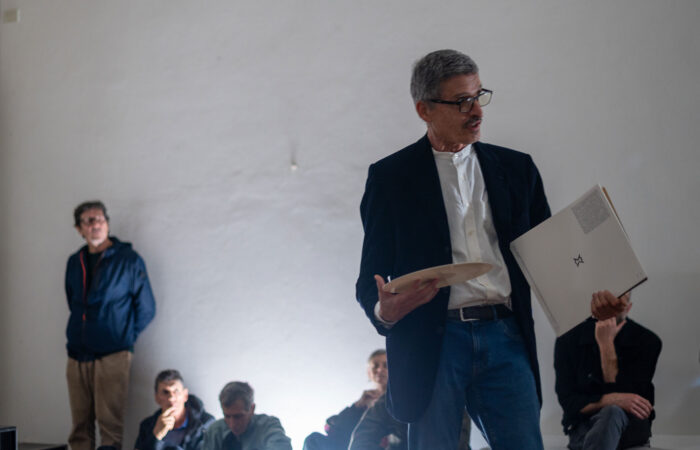
XING: By dint of working with sound material for the preparation of the record was there a perceptual shift—and naming—from noise to sound for you? Trivially, it is said that a noise is judged as unpleasant, while a sound is perceived as “musical.” Obviously it is a cultural fact, beyond the concrete difference whether sound waves are regular or not. In the record, there is an acoustic reality that is circumscribed and described, placed side by side with a composition, however arbitrary, such as the fall suite. Sound or noise?
Speaking of field recordings, in NEWTON we are dealing with man-made interiors and exteriors, fragments of both public and private life instead of natural environments. In NEWTON there is also a documentary or sociological aspect, between professional and private spheres that speaks of contexts, the life of an artist, the places he attends, idiosyncrasies, habits.
Cesare Pietroiusti: The slavishly-made recordings return a sequence of very ordinary situations: making coffee upon waking up, a train ride, computer work, paying at the cashier at the coffee shop. The life of an artist is an ordinary life in which, however, the modes of attention change. To pay attention, for example, to one’s mistakes or failures, is not just “psychopathology of everyday life;” for the artist it is to gather material, to do research, to acquire tools for one’s works, and perhaps, on an ethical level, to get used to thinking-well-of-the-bad, because what “disturbs” can be used… Sometimes, then, one can devote this kind of attention even to the details of our language. When, a few minutes ago, I wrote, in the previous paragraph, “to pay attention,” (fare caso, in Italian), I thought about how many subtleties of meaning converge on this syntagma: the unique case, the example, or the attention that falls precisely on a certain point and not another. Here, for me the artist is the one who brings their and others’ attention to fall where it was not intended, thereby opening up fields of possibility of meaning, of action, of relationship.
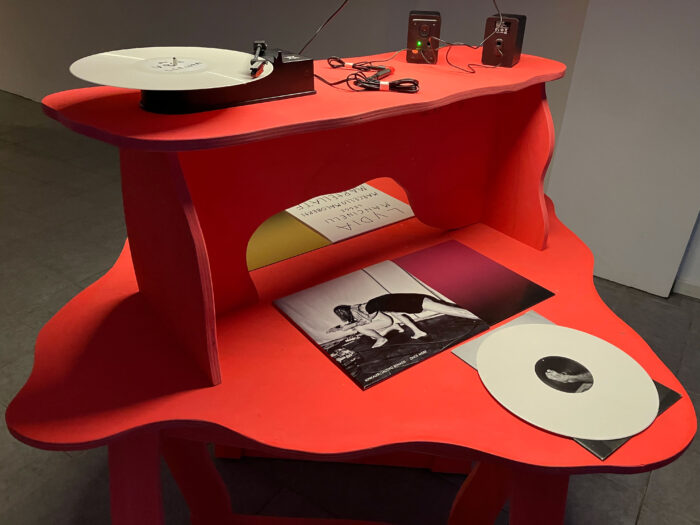
XING: The white vinyl as page, sound as writing.
Cesare Pietroiusti: The record and its cover—thanks to you—are extremely elegant. In my opinion, rather than the metaphor of the blank page, which is waiting for a manifestation of language to be accommodated, this object speaks to us of the absolute, the Principium, the omnipresent that is so inevitable that we do not notice it. Somehow the force of gravity is the basis of being, the “white” on which every body becomes grave and its every motion becomes noise. So yes, you are right, the sound here is the trace of all the motions of the grave, be they candies, used tissues, or plastic caps.

LP back cover Xong collection – artist records (detail). Courtesy Xing.
XING: For the collector’s edition, a mail art operation was carried out, where the stamps became also objects of use in their symbolic value of collectibles (records are also part of this sphere between outdatedness and collecting).
Cesare Pietroiusti: When my father died a few years ago, I inherited a large stamp collection. After a few attempts to resell it, I decided to keep it and use them in my own work. There are so many states in the world that have dedicated one or more stamps to Isaac Newton: France, Hungary, Chad, Congo, Russia, Great Britain, San Marino, etc. (Italy has not, or not yet). So I thought of franking the envelopes with the vinyl of the thirty “collector’s copies” with these stamps, and entrusting this collector’s item to the national postal service, which, by now, no longer uses stamps and produces anonymous and insignificant envelopes. It is a personal tribute to those who decide to spend 200 euros on this record, and it is a tribute to the vanishing aesthetics of the postage stamp, to the physicality of those coloured rectangles that, a few years ago, had to pass over the tongue before being stuck on the envelope.
For me, the vinyl record has always represented a dimension of delicate and precious physicality: I think of the gesture of the hands pulling it out of the cover, without the fingers touching the grooves… Besides, woe betide dropping a record!
XING: For Xing, the Xong collection project is within certain limits the summoning of a scene. Also because of your recent professional endeavours you moved closer to the performance context, Italian and otherwise. There is this issue of recognizability about these authors and the somewhat expanded and transversal practices they carry on.
Maybe records, if they fall, don’t shatter, at least not like ceramic plates. But certainly, if there is a fall that we can consider to some extent positive, it is the seminal one, which we want to pick up and acknowledge anyway.
Speaking about current references: small Italian labels such as Hundebiss, Presto!?, Musica Moderna, and VON, founded and run by artist friends (in order Simone Trabucchi of Invernomuto; Lorenzo Senni; Claudio Rocchetti and Matteo Castro; Nico Vascellari and Carlos Casas) despite the diversity of orientation, were important because they introduced, nourished and pushed us toward self-production of records, demonstrating how this was an organic a part of a creative cycle based on liveness. The 2000s scene widened the expressive range, taking on an “undisciplined” and “extra-disciplinary” perspective made up of transitions, escapes, reinventions, and traversal encounters.
It is this openness around live arts artists that implies a mature experiment like Xong. It is already 25 years of activity for this Italian scene, and it was time to present it as a collection.
The series actually aspires to give a portrait of each artist’s personality, in their originality. There are very different aesthetics. Of course, we remain under the umbrella of experimentation or sound art, but then we go from Lydia Mancinelli’s spoken word for Marcello Maloberti’s slogans to Mattin’s activist noise, from Alessandro Bosetti’s phonatory recombination to Invernomuto’s inauthentic vernacular, from Ilaria Lemmo’s spectralism with Margherita Morgantin to Jacopo Benassi and Kinkaleri’s hard core, to Luciano Maggiore’s anti-specist improvisation, from musique concrète, electroacoustic and acousmatic music of Valerio Tricoli, Canedicoda, Renato Grieco, Daniela Cattivelli, to the techno of Scott Gibbons and Castellucci, to the tigrinyo rhythm in circular speculation of Mussie and Carozzi, from the surrealist poetry of Giampiero Cane to the noisy travelogues arranged by Bea Goldoni, to Mette Edvardsen’s field recordings of a living room, to the glass music of Francesco Cavaliere…
For us it was clear that these artists were adopting cross-cutting practices, even limited to live arts, potentially ready for this proposal. Many of Xong’s artists had never made a record. Perhaps they will never make one again, but certainly, in the meantime, a historical cycle is looming.
[*] Among the few publications/inventories:
– Giorgio Maffei, Records by artists, 1958-1990, Viaindustriae/Danilo Montanari, 2013.
– Germano Celant, The Record as Artwork from Futurism to Conceptual Arts, Celant Collection Catalogue, The Fort Worth Art Museum, USA, 1977.
– Germano Celant, Art or Sound, Fondazione Prada exhibition catalogue, 2024.


